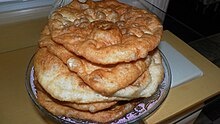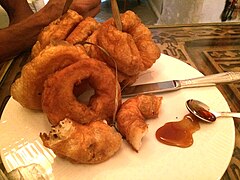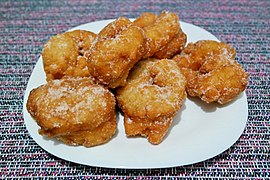Sfenj
 | |||||||
| Alternative names | Bambalouni, khfaf, sfinz | ||||||
|---|---|---|---|---|---|---|---|
| Type | Doughnut | ||||||
| Place of origin | Maghreb | ||||||
| Main ingredients | Flour, water, sugar, yeast and salt | ||||||
| 137kcal(574kJ)[1] | |||||||
| |||||||
Sfenj(from theArabicwordArabic:سفنج,romanized:Safanj,meaningsponge) is aMaghrebidoughnut:a light, spongy ring of dough fried inoil.Sfenj is eaten plain, sprinkled withsugar,or soaked inhoney.It is a well-known dish in the Maghreb and is traditionally made and sold early in the morning for breakfast or in the late afternoon accompanied bytea—usuallyMaghrebi mint tea—orcoffee.[2]The term Sfenj is used inAlgeriaand other parts of theMaghreb.It is calledbambalouniinTunisia,[3]andSfenjinLibya.[4]InMorocco,the term "Sfenj" is used, also sometimes nicknamed in the literature "Moroccan doughnuts".[5][6][7]It is also calledKhfaforftayrinAlgeria,[8][9][10]and is sometimes also dubbed as the "Algerian doughnut".[11][12]
History
[edit]Sfenj originated inAl-Andalus(Moorish Spain). According to legend, Sfenj was created by mistake, when a baker accidentally dropped a ball of dough into a pan of hot oil.[13]Sfenj was an important part of Andalusi culture, whose role was best summarised by a verse from a contemporary poet: "The Sfenj bakers are worth as much as kings" ( "سفاجين تحسبهم ملوكا").[14]
It is unclear how Sfenj first spread to the Maghreb, although it is said to have been well known to theMarinid Dynasty,which ruledMoroccofrom 1270 to 1465. It spread toFranceduring the 13th century, where it inspiredbeignets.[14]Sfenj were only sweetened with sugar starting in the 18th century, even thoughsugarcanehas been widely cultivated in theArab worldsince the 8th century. Before that, they were sweetened with honey orsyrup,or simply served plain.[14]
Although Sfenj comes from Al-Andalus, most bakers and sellers of Sfenj in the Maghreb have traditionally beenAmazigh(Berbers). The nomadic Amazigh are thought to have spread Sfenj throughout the Maghreb, aided in that by merchants who traveled across the region.[14]
The chefMustafa an-Nakīrremarks that head meat withSfenjwas a popular breakfast inMarrakeshin his grandparents' time.[15]
Dedicated Sfenj bakers, calledsufnāj(سفناج), soon appeared throughout theMaghreb,attesting to the dessert's popularity.Sufnājeen(plural ofsufnāj) became central figures in the social life ofMaghrebineighborhoods, as they interacted with almost every household in their community every morning, and working as asufnājwas considered a respectable career. In a traditional Sfenj bakery, thesufnāj(and their large circular fryer) sit on an elevated platform, raised slightly above the rest of the bakery, which is already raised more than a meter off the ground. Customers surround this platform and try to catch thesufnāj's attention to place their orders by raising their hand at him or her and shouting.[13][14]
Traditionalsufnājeenare quickly going extinct in the modern Maghreb, as a result of the rise of industrial bakeries and the proliferation of Sfenj recipes over theInternetblogosphere.[13]
Sfenj in Libya
[edit]
InLibyaSfenj is eaten sprinkled withsugaror soaked inhoneyor date molasses. It can be eaten for Friday breakfast or withafternoon tea.[16]Though it is eaten year-round,[17]it is especially popular during the winter months and aroundRamadanandEid al-Fitr.[18]It is the Libyan version of the Sfenj[19]doughnuts that are widely popular across the other countries of theMaghreb.[4]
Sfenj can also be prepared with afried eggin the center.[18]The egg can be runny or hard, and is often topped with cheese.[4][17]
Sfenj in Israeli culture
[edit]
Sfenj (Hebrew:סְפינְג',romanized:Sfinj) entered Israeli culture before 1948, as Maghrebi Jews brought it with them when they immigrated toMandatory Palestine.[20]Sfenj quickly became popular forHanukkah,as it is easy to prepare at home. However, Sfenj's ease of preparation contributed to its loss of popularity in Israel when theHistadrut,Israel's national labor union, pushed to make the jelly-filledsufganiyahthe traditional food of Hanukkah, during the late 1920s. Making sufganiyot well can only be done by professional bakers, and the Histadrut wanted sufganiyot to supplant the home-madelatkesin order to secure jobs for Jewish bakers.[21]Their effort was successful: by 2016, Israel's 7 million Jews were eating 20 million sufganiyot per year.[22]More Israeli Jews report eating sufganiyot for Hanukkah than fasting forYom Kippur.[21][23]
Varieties
[edit]In addition to ordinary Sfenj, there are two special varieties of Sfenj, not counting the different toppings (honey, syrup, and sugar) Sfenj can have:[13]
- Sfenj matifiyya(السفنج المطفية), Sfenj that is pounded flat and then fried a second time
- Sfenj matifiyya bil-baydh(السفنجة المطفية بالبيض), Sfenj matifiyya with aneggadded before refrying
In language
[edit]Sfenj's importance to Moroccan culture is reflected in severalidiomsinMoroccan Arabic,including:[14]
- "Give someone a Sfenj and he'll say it's ugly" (صاب سفنجة وقال عوجة), meaning "do not judge a book by its cover"or"do not bite the hand that feeds you."
- "As if hitting a dog with a Sfenj" (بحال يلا ضربتي كلب باسفنجة), meaning a futile orSisypheanendeavor, especially an act of pointless petty revenge (because if someone hits a dog with a Sfenj, the dog will eat and like it).
- "Demanding oil from asufnāj"(طلب الزيت من سفناج), meaning "taking from the needy" (because asufnāj—a Sfenj baker—uses large amounts of cooking oil).
Gallery
[edit]-
Sfenj being deep-fried in a traditional tilted deep fryer in Marrakesh, Morocco. The Sfenj are placed on the edge with no oil to fry the bottom and inflate the dough. Once fully inflated they are moved into the hot oil.
-
Sfenj in Essaouira Morocco. Sfenj are still bound together by passing a length of palm frond through the center as is pictured here.
-
Method for making Sfenj in Algeria
-
Khfaf fromKabyliein Algeria
-
Sfenj sprinkled with sugar and served on a plate
See also
[edit]- Malasada,the Portuguese equivalent
- Buñuelo,the Latin American equivalent
- Frittelle,the Italian equivalent
- List of doughnut varieties
References
[edit]- ^Benlafouih, Caroline."Sfenj Recipe - Moroccan Doughnuts or Fritters".The Spruce Eats.Retrieved31 May2018.
- ^"Sfenj"سفنج.طبخ.org(in Arabic). tabkh maghribi. 2012.Retrieved31 May2018.
- ^"Recette de Bambalouni - Sfenj".Chahia Tayba(in French). 2011.Retrieved1 June2018.
- ^abcHamza, Umm (9 April 2015)."SFINZ / SFENJ".Halal Home Cooking.Retrieved7 August2018.
- ^Ahmed Chouari (27 July 2021). "Memories of Jewish-Muslim Co-existence in the newMellaḥof Meknes and Jewish Heritage Conservation in Post-Colonial Morocco ". In Joseph Chetrit; Jane S. Gerber; Drora Arussy (eds.).Jews and Muslims in Morocco, Their Intersecting Worlds.Le xing ton Books. p. 382.ISBN9781793624932.
- ^Gordon Rock (30 April 2020).A King's Feast: 40 Aromatic and Exotic Moroccan Recipes - The Best Cookbook to Celebrate Moroccan Independence Day.
- ^Copeland Marks (1994).The Great Book of Couscous: Classic Cuisines of Morocco, Algeria, and Tunisia.the University of Virginia. p. 62-63.ISBN9781556114205.
- ^Bouksani, Louisa (1989).Gastronomie Algérienne.Alger, Ed. Jefal. p. 184.
- ^Nas E. Boutammina (2022).Le numide, langue populaire de la Berbérie.BoD - Books on Demand. p. 77.ISBN978-2-322-41710-0.
- ^Scheherazade, Jawahir (24 November 2014)."Sfenj à la farine".Joyaux Sherazade(in French).Retrieved1 June2018.
- ^"Sfenj – Algerian doughnuts".Miam Miam & Yum.3 June 2016. Archived fromthe originalon 22 May 2022.Retrieved8 April2022.
- ^Stephanou, Marina (17 February 2021)."Sfenj (Doughnut): the Sweet Sensation of Algeria's Cross-Cultural Cuisine".pan-African.Retrieved8 April2022.
- ^abcdالرحالي, خديجة (7 October 2011)."السفناج" مهنة عريقة في المغرب العربي في طريقها للاندثار.Asharq Al-Awsat(in Arabic). No. 12001.Retrieved31 May2018.
- ^abcdefأوالفقر, حسن (24 March 2004)."الاسفنج" فطائر مغربية تحضر الى المائدة من بطون التاريخ!.Asharq Al-Awsat(in Arabic). No. 9248.Retrieved31 May2018.
- ^"أساطير أكل الشارع: الأمين الحاج مصطفى".Hespress - هسبريس جريدة إلكترونية مغربية(in Arabic). 14 April 2021.Retrieved25 May2023.
- ^Libyan Dougnut: Sfinz (سفنز (معجنات مقلية.Libyan food.17 December 2010.Retrieved7 August2018.
- ^abAlharathy, Safa (26 August 2017)."Libyan Cuisine: Sfinz".Libyan Observer.Retrieved7 August2018.
- ^abالسفنز على الطريقة الليبية.بوابة الوسط الليبي(in Arabic). 24 October 2014.Retrieved7 August2018.
- ^Also known as khfaf inAlgeriaand yo-yos inTunisia
- ^Kaufman, Jared (21 February 2018)."Never Underestimate The Doughnut Lobby".Roads & Kingdoms.Retrieved31 May2018.
- ^abGreen Ungar, Carol (Winter 2012)."The" Hole "Truth About Sufganiyot".Jewish Action.Orthodox Union.Retrieved31 May2018.
- ^Solomonov, Michael (1 December 2016)."Why Sfenj Couldn't Be the Official Dessert of Hanukkah".Food52.Retrieved31 May2018.
- ^Nachshoni, Kobi (13 September 2013)."Poll: 73% of Israelis fast on Yom Kippur".YNet.Retrieved31 May2018.
External links
[edit]- Sfenj/Sfenj recipe
- Sfenj recipefrom theLibyan Observer






